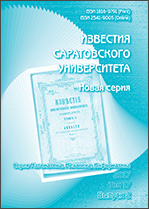|
This article is cited in 8 scientific papers (total in 8 papers)
Scientific Part
Mechanics
Influence of convolution kernel and beam-hardening effect on the assessment of trabecular bone mineral density using quantitative computed tomography
D. V. Ivanova, I. V. Kirillovaa, L. Yu. Kossovicha, L. V. Bessonova, A. V. Petraikinb, A. V. Dola, E. S. Ahmadb, S. P. Morozovb, A. V. Vladzymyrskyyb, K. A. Sergunovab, A. V. Kharlamova
a Saratov State University, 83 Astrakhanskaya St., Saratov 410012, Russia
b State Budget-Funded Health Care Institution of the City of Moscow “Research and Practical Clinical Center for Diagnostics and Telemedicine Technologies of Moscow Health Care Department”, 28-1 Srednyaya Kalitnikovskaya St., Moscow 109029, Russia
Abstract:
Quantitative computed tomography along with densitometry is used to assess mineral density and strength of bone tissue. Raw data obtained by computed tomography are converted by software using convolution kernels. It is known that the use of convolution kernels can significantly change tissue density, which is measured in Hounsfield units. The beam-hardening effect is described in literature: when x-ray passes through an object, the absorption of lower-energy x-ray photons occurs. Therefore, scanning objects “in the air” without surrounding soft tissues of the human body gives distorted Hounsfield units relative to their real values. This work is aimed at assessing the effect of various convolution kernels, beam-hardening effect, as well as other CT scanner settings for Hounsfield units. In this work, we studied samples of trabecular bone tissue of the femoral heads and calibrated samples of an aqueous solution of dipotassium hydrogen phosphate with known mineral density. Trabecular bone tissue samples of the femoral heads and calibrated samples of an aqueous solution of dipotassium hydrogen phosphate with known mineral density were scanned on Toshiba Aquilion 64 scanner. The samples were scanned in various modes: at different tube currents, “in the air” and inside the calibration phantom. The resulting images processed by the FC17 and FC03 convolution kernels were analyzed. It was shown that tube current magnitude practically does not affect the Hounsfield units. Different convolution kernels demonstrate significantly different Hounsfield units when scanning the same samples “in the air”. It has been confirmed that the beam-hardening effect significantly affects the Hounsfield units and should be considered when evaluating bone mineral density. No differences were found in measurements “in the air' and in the phantom at a significance level of 5% for the FC03 kernel, which confirms the fact that FC03 is intended to correct the beam-hardening effect. An ambiguous relationship was noted between the Hounsfield units and the mineral density for low-density samples when scanned with the FC03 kernel. FC17 kernel, in comparison with FC03, is considered more preferable and suitable for assessing bone mineral density. However, pre-calibration with phantom is required for a wide range of preset mineral densities. Regression dependencies were obtained for recalculation of Hounsfield units from experiments "in the air” to Hounsfield units of the same samples scanned in surrounding tissues (in the phantom).
Key words:
computed tomography, quantitative computed tomography, bone mineral density, Hounsfield unit, convolution kernel.
Received: 15.12.2019
Accepted: 22.01.2020
Citation:
D. V. Ivanov, I. V. Kirillova, L. Yu. Kossovich, L. V. Bessonov, A. V. Petraikin, A. V. Dol, E. S. Ahmad, S. P. Morozov, A. V. Vladzymyrskyy, K. A. Sergunova, A. V. Kharlamov, “Influence of convolution kernel and beam-hardening effect on the assessment of trabecular bone mineral density using quantitative computed tomography”, Izv. Saratov Univ. Math. Mech. Inform., 20:2 (2020), 205–219
Linking options:
https://www.mathnet.ru/eng/isu839 https://www.mathnet.ru/eng/isu/v20/i2/p205
|

| Statistics & downloads: |
| Abstract page: | 255 | | Full-text PDF : | 142 | | References: | 28 |
|




 Contact us:
Contact us: Terms of Use
Terms of Use
 Registration to the website
Registration to the website Logotypes
Logotypes








 Citation in format
Citation in format 
